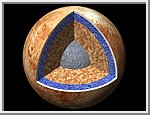 The Core is surrounded by a rock shell
(brown). The rock layer of Europa (drawn to correct relative size) is in turn
surrounded by a shell of water in ice or liquid form(shows in blue and white and
drawn to the correct relative scale)
The Core is surrounded by a rock shell
(brown). The rock layer of Europa (drawn to correct relative size) is in turn
surrounded by a shell of water in ice or liquid form(shows in blue and white and
drawn to the correct relative scale)Explanation of Europa
- Europa is sixth of Jupiter’s known satellites and the fourth largest
- Slightly smaller than the earth’s moon
- Primarily composed of silicate rock, thin outer layer of ice
- The following interior characteristics are inferred from gravity field and magnetic field measurements by the Galileo spacecraft. Europa has a layered internal structure perhaps with a small metallic (iron, nickel) core (shows in gray)
(INTERIOR of Europa)
 The Core is surrounded by a rock shell
(brown). The rock layer of Europa (drawn to correct relative size) is in turn
surrounded by a shell of water in ice or liquid form(shows in blue and white and
drawn to the correct relative scale)
The Core is surrounded by a rock shell
(brown). The rock layer of Europa (drawn to correct relative size) is in turn
surrounded by a shell of water in ice or liquid form(shows in blue and white and
drawn to the correct relative scale)
- This artistic picture represents Europa during the dawn of the Solar System’s creation. At this point in time, oceans graced the surface of Europa. Since liquid water existed in the past, could life have formed and even exist today? Europa has all three primary ingredients for life-water, heat, and organic compounds obtained from comets and meteorites. The possible subsurface ocean that scientists believe exists should have frozen long ago, but warming could be occurring due to the tidal tug of war with Jupiter and neighboring moons.
- Europa’s surface is unlike anything in the solar system-exceedingly smooth-few features more than a few hundred meters high have ever been seen-prominent markings seem to be only Albedo features with very low relief
- Few craters on Europa, only three craters larger than 5 km in diameter have been found-this indicates a young and active surface
- Images of Europa surface strikingly resemble images of sea ice on earth, possible that beneath Europa’s surface ice there is a layer of liquid water-perhaps as much as 50 km deep, kept liquid by tidally generated heat. If true, only place in our solar system besides Earth where liquid water exists in significant quantities
- Most striking aspect of Europa is a series of dark streaks crisscrossing the entire globe. Larger ones are roughly 20km across with diffuse outer edges and a central band of lighter material. Latest theory of their origin is that they are produced by a series of volcanic eruptions or geysers
- Europa has a very tenuous atmosphere composed of oxygen. Unlike oxygen in earth’s atmosphere, Europa’s is almost certainly not of biologic origin. Most likely is generated by sunlight and charged particles hitting Europa’s icy surface producing water vapor which is subsequently split into hydrogen and oxygen. Hydrogen escapes leaving the oxygen.
- One of brightest surfaces in the solar system, a consequence of sunlight reflecting off a relatively young icy crust.
- Most recent mission to Europa-“Galileo-Europa Mission-” closest fly by ever-key findings include: discovery of volcanic flows and melting or “rafting” of ice on the surface that supports the premise of liquid oceans underneath at some point in Europe’s history; definite presence of metallic core in Europa;
- Europa encounter shows more evidence that the moon has been subjected to intense geological deformation. Picture shows a mottled region of dark and splotchy terrain that scientists say represents some of the most recent geologic activity on Europa.
- Only place in solar system with similar features of icy frozen areas is Arctic seas on earth. Icy crust is believed to be floating on a vast liquid ocean just like Arctic icebergs
- DOES EUROPA SHOW POSSIBLE SIGNS OF LIFE??
- Europa contains all chemicals necessary for life to begin. All that is missing is liquid water, if an ocean is present under crust, the ocean may contain life.
- In order to create life, a planet or moon also needs heat. Icy surface is most likely too thick for sunlight and heat; Europa gets its heat from “tidal forces” which heat up Europa’s core. “Tidal forces” are the different gravitational pulls and forces that Europa has from Jupiter and other moons around the planet. Different forces all pulling in different directions yanking Europa’s surface out of shape as it travels through space. If forces are strong enough, then the core could heat up enough to melt the frozen water surrounding it.
- Europa’s ocean may possibly contain hotspots called “hydrothermal vents”- cracks in the ground that spout warm, nutrient-rich water. On earth, hydrothermal vents harbor many simple life forms.
- Many of these statements are inconclusive, but the theories do have definite reasoning and further research and exploration will tell if they are correct.
- Europa is a bright white in color
- Europa’s radius is 1565 km, a little bit smaller than our moon’s radius